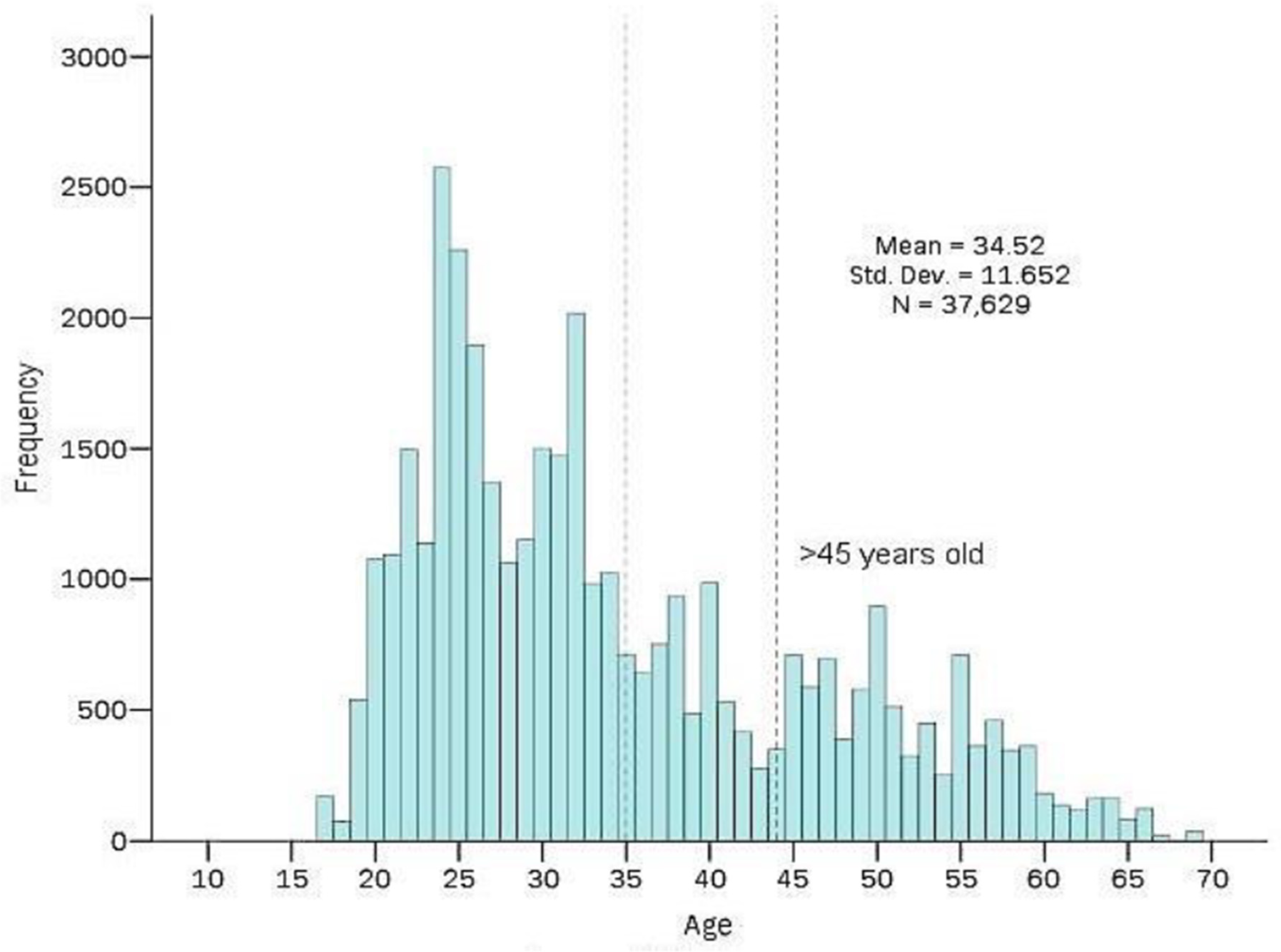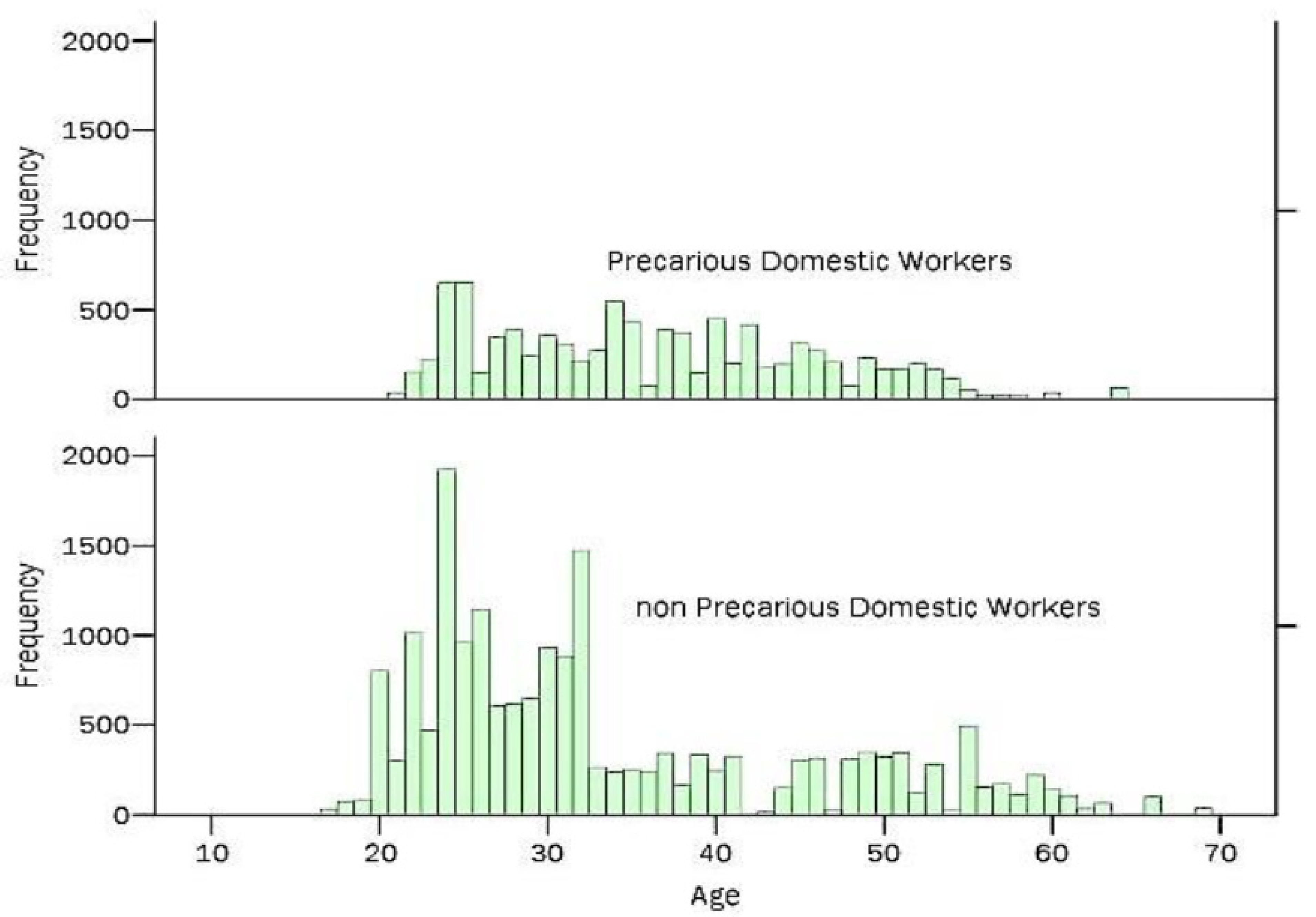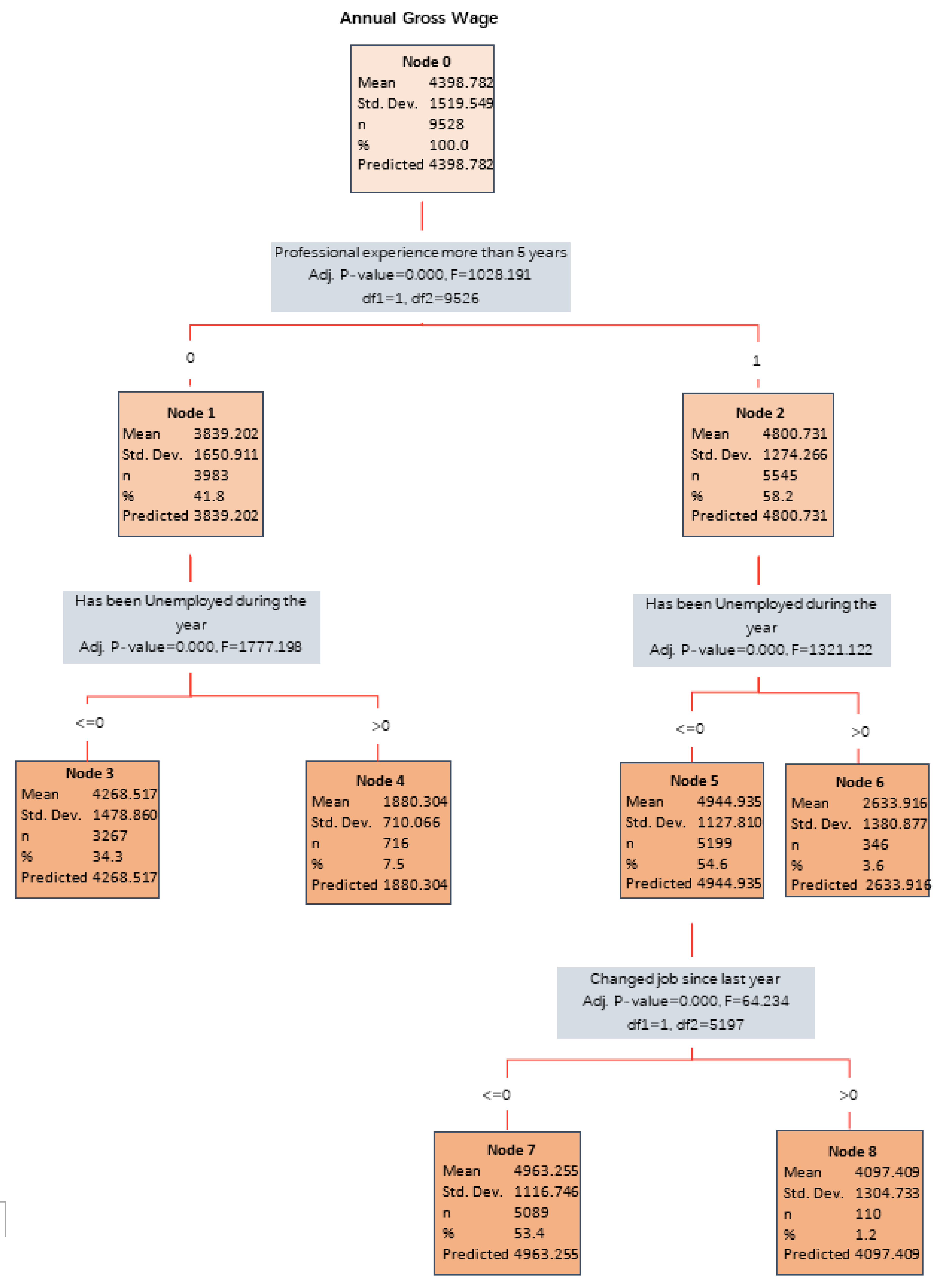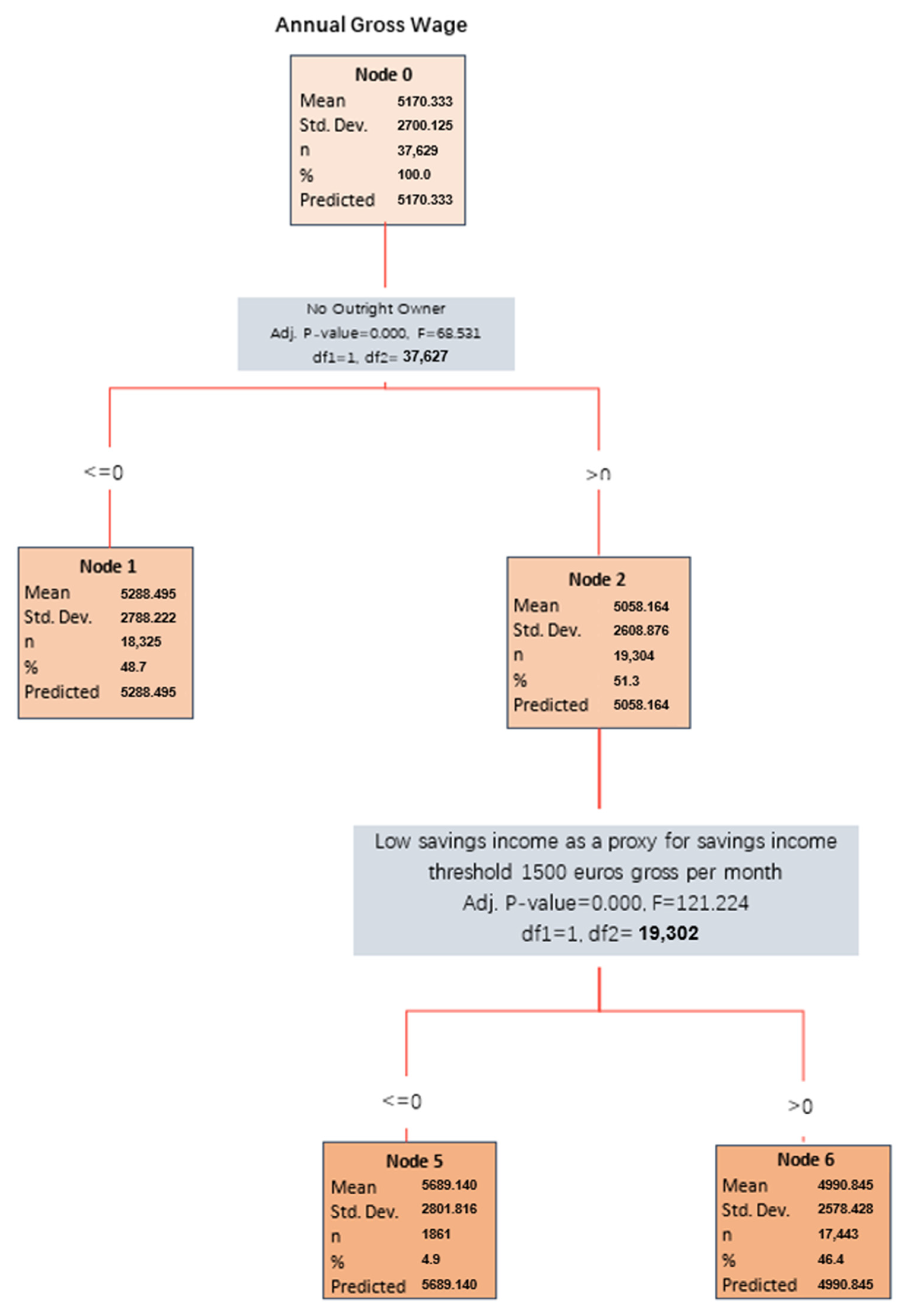Mapping and Measuring the Phenomenon of Precariousness in the Labour Market: Challenges and Implications
Abstract
1. Introduction
1.1. Theoretical and Conceptual Framework
1.2. Defining a Framework of Indicators and Contributions
2. Materials and Methods
2.1. Research Questions
- RQ1:
- What is the profile of precarious workers, and how can they be mapped in the Cyprus labour market?
- RQ2:
- What are the determining factors affecting the risk of precariousness?
- RQ3:
- Do economic vulnerability and precarious work meet with each other, and if so, where?
- (1)
- Wi: the wage of i worker, relative to the median;
- (2)
- NpCi: the kind of contract (permanent or temporary work) of the i worker;
- (3)
- Tui: the duration of unemployment periods of the i worker;
- (4)
- (5)
- UBi: the i worker’s entitled unemployment benefits (UB).
2.1.1. Determining the Factors Affecting the Risk of Precariousness
2.1.2. Intersections between Economic Vulnerability and Precariousness
2.2. Three Indicators
2.2.1. Indicator 1: Precariousness Indicator
- Precariousness Indicatori: is the Precariousness indicator of the i worker;
- Wi:
- the wage of the i worker, which is relative to the median in order to capture the worker’s position in the wage set, or else, if she/he has a precarious wage;
- NpCi:
- the contract aspect of precarious employment of the i worker by identifying if an individual has permanent or temporary work, which corresponds to a contract with a limited duration (value 1 for temporary work, otherwise 0);
- Tui:
- the duration of the unemployment periods for i precarious worker. If the unemployment duration is below a certain threshold, the variable takes on value 0, and value 1 otherwise.
2.2.2. Indicator 2: Vulnerability
2.2.3. Indicator 3: Precarity
3. Results
3.1. Profiling and Mapping the Precarious Workers and Precariousness
3.2. Factors Affecting Labour Income of the Precarious Workers
3.3. What Makes a Precarious Worker? Determining Factors Affecting the Risk of Precariousness
3.4. Precarity: Where Economic Vulnerability and Precarious Work Meet and Intersect
3.5. Focus Group
4. Discussion and Conclusions
5. Limitations
6. Future Research
Author Contributions
Funding
Institutional Review Board Statement
Informed Consent Statement
Data Availability Statement
Conflicts of Interest
References
- Anderson, Bridget. 2007. A Very Private Business: Exploring the Demand for Migrant Domestic Workers. European Journal of Women’s Studies 14: 247–64. [Google Scholar] [CrossRef]
- Barbier, Jean-Claude. 2004. A comparative analysis of ‘employment precariousness’ in Europe. European Research Centre, Cross-National Research Papers 7: 7–18. [Google Scholar]
- Bourdieu, Pierre. 1998. Acts of Resistance Against the New Myths of our Time. Cambridge: Polity Press. [Google Scholar]
- Brinkmann, Svend. 2014. Unstructured and semi-structured interviewing. In The Oxford Handbook of Qualitative Research. New York: Oxford University Press, pp. 277–99. [Google Scholar]
- Castel, Robert. 2003. From Manual Workers to Wage Labourers: Transformation of the Social Question. New Brunswick and London: Transaction Publishers. [Google Scholar]
- Castel, Robert. 2016. The Rise of Uncertainties. Critical Horizons 17: 160–67. [Google Scholar] [CrossRef]
- De Genova, Nicolas. 2002. Migrant “Illegality” and Deportability in Everyday Life. Annual Review of Anthropology 31: 419–47. [Google Scholar] [CrossRef]
- da Silva, António Dias, and Alessandro Turrini. 2015. Precarious and Less Well-Paid? Wage Differences between Permanent and Fixed-Term Contracts across the EU Countries. European Economy, Economic Papers No. 544. Brussels: European Commission. [Google Scholar]
- Duclos, Jean-Yves, and Magda Mercader-Prats. 2005. Household needs and Poverty: With application to Spain and the UK. The Review of Income and Wealth 45: 77–98. [Google Scholar] [CrossRef]
- Eurostat. 2020. European Union Statistics on Income and Living Conditions. Available online: https://ec.europa.eu/eurostat/web/products-eurostat-news/-/wdn-20211230-1 (accessed on 11 January 2023).
- García-Pérez, Carmelo, Mercedes Prieto-Alaiz, and Hipolito Simon. 2017. A new multidimensional approach to measuring precarious employment. Social Indicators Research 134: 437–54. [Google Scholar] [CrossRef]
- Hadjigeorgiou, Nasia. 2020. Exploring the Socio-legal Challenges Faced by Foreign Domestic Workers in Cyprus (Report funded by the London School of Economics—Hellenic Observatory). Available online: https://www.lse.ac.uk/Hellenic-Observatory/Research/Cyprus-Projects-2019-2020/Exploring-the-Socio-legal-Challenges-Faced-by-Foreign-Domestic-Workers-in-Cyprus (accessed on 23 November 2021).
- Kalleberg, Arne L. 2009. Precarious work, insecure workers: Employment relations in transition. American Sociological Review 74: 1–22. [Google Scholar] [CrossRef]
- Kalleberg, Arne L. 2011. Good Jobs, Bad Jobs, The Rise of Polarized and Precarious Employment Systems in the United States, 1970s to 2000s. A Volume in the American Sociological Association’s Rose Series in Sociology. New York: Russell Sage Foundation. [Google Scholar]
- Kalleberg, Arne L. 2018. Job insecurity and well-being in rich democracies. The Economic and Social Review 49: 241–58. [Google Scholar] [PubMed]
- Kretsos, Lefteris, and Ilias Livanos. 2016. The extent and determinants of precarious employment in Europe. International Journal of Manpower 37: 25–43. [Google Scholar] [CrossRef]
- Lewis, Hannah, Peter Dwyer, Stuart Hodkinson, and Louise Waite. 2015. Hyper-precarious lives: Migrants, work and forced Labour in the Global North. Progress in Human Geography 39: 580–600. [Google Scholar] [CrossRef]
- Morgan, David L., and Richard A. Krueger. 1993. When to use focus groups and why. Successful Focus Groups: Advancing the State of the Art 1: 3–19. [Google Scholar]
- Olsthoorn, Martin. 2014. Measuring Precarious Employment: A Proposal for Two Indicators of Precarious Employment Based on Set-Theory and Tested with Dutch Labour Market-Data. Social Indicators Research 119: 421–41. [Google Scholar] [CrossRef]
- Paugam, Serge. 2017. Poverty and Attachment Regimes in Modern Societies. In Soziale Bildungsarbeit—Europäische Debatten und Projekte. Soziale Arbeit als Wohlfahrtsproduktion. Edited by Joachim Schroeder, Louis Seukwa and Ulrike Voigtsberger. Wiesbaden: Springer VS, vol. 14. [Google Scholar] [CrossRef]
- Paugam, Serge. 2020. Se sentir pauvre: Un indicateur spécifique de l’insécurité sociale? Revue Française de Sociologie 61: 281–92. [Google Scholar] [CrossRef]
- Pitrou, Agnès. 1978. La vie précaire: Des familles face à leurs difficultés. In Caisse Nationale des Allocations Familiales. Madison: Laboratoire d’économie et de sociologie du travail. University of Wisconsin, vol. 21. [Google Scholar]
- Puig-Barrachina, Vanessa, Christophe Vanroelen, Alejandra Vives, José Miguel Martínez, Carles Muntaner, Katia Levecque, Joan Benach, and Fred Louckx. 2014. Measuring employment precariousness in the European Working Conditions Survey: The social distribution in Europe. Work 49: 143–61. [Google Scholar] [CrossRef] [PubMed]
- Republic of Cyprus—Department of Labour Relations. 2021. Is the 13th and/or 14th Salary Mandatory? Ministry of Labour and Social Insurance. Available online: https://www.mlsi.gov.cy/mlsi/dlr/dlr.nsf/All/D884920734AE50B8C22586870039FD16?OpenDocument (accessed on 5 January 2023).
- Rodgers, Gerry, and Janine Rodgers, eds. 1989. Precarious Jobs in Labour Market Regulation: The Growth of Atypical Employment in Western Europe. Geneva: International Labour Organisation-ILO. [Google Scholar]
- Spyridakis, Manos. 2018. Homo Precarious: Experiences of Vulnerability during the Crisis. Athens: Pedio Publ. (In Greek) [Google Scholar]
- Standing, Guy. 2009. Work after Globalisation: Building occupational Citizenship. Cheltenham: Edward Elgar. [Google Scholar]
- Standing, Guy. 2011. The Precariat, the New Dangerous Class. London: Bloomsbury Publishing Plc. [Google Scholar]
- Tompa, Emile, Heather Scott-Marshall, Roman Dolinschi, Scott Trevithick, and Sudipa Bhattacharyya. 2007. Precarious employment experiences and their health consequences: Towards a theoretical framework. Work 28: 209–24. [Google Scholar] [PubMed]
- Unt, Marge, Michael Gebel, Sonia Bertolini, Vassiliki Deliyanni-Kouimtzi, and Dirk Hofäcker, eds. 2021. Social Exclusion of Youth in Europe: The Multifaceted Consequences of Labour Market Insecurity. Great Britain: Bristol University Press. [Google Scholar]
- Vosko, F. Leah, ed. 2006. Precarious Employment: Understanding Labour Market Insecurity in Canada. Montreal and Kingston-London-Ithaca: McGill-Queen’s University Press-MQUP. [Google Scholar]
- Waite, Louise. 2009. A place and space for a critical geography of precarity? Geography Compass 3: 412–33. [Google Scholar] [CrossRef]


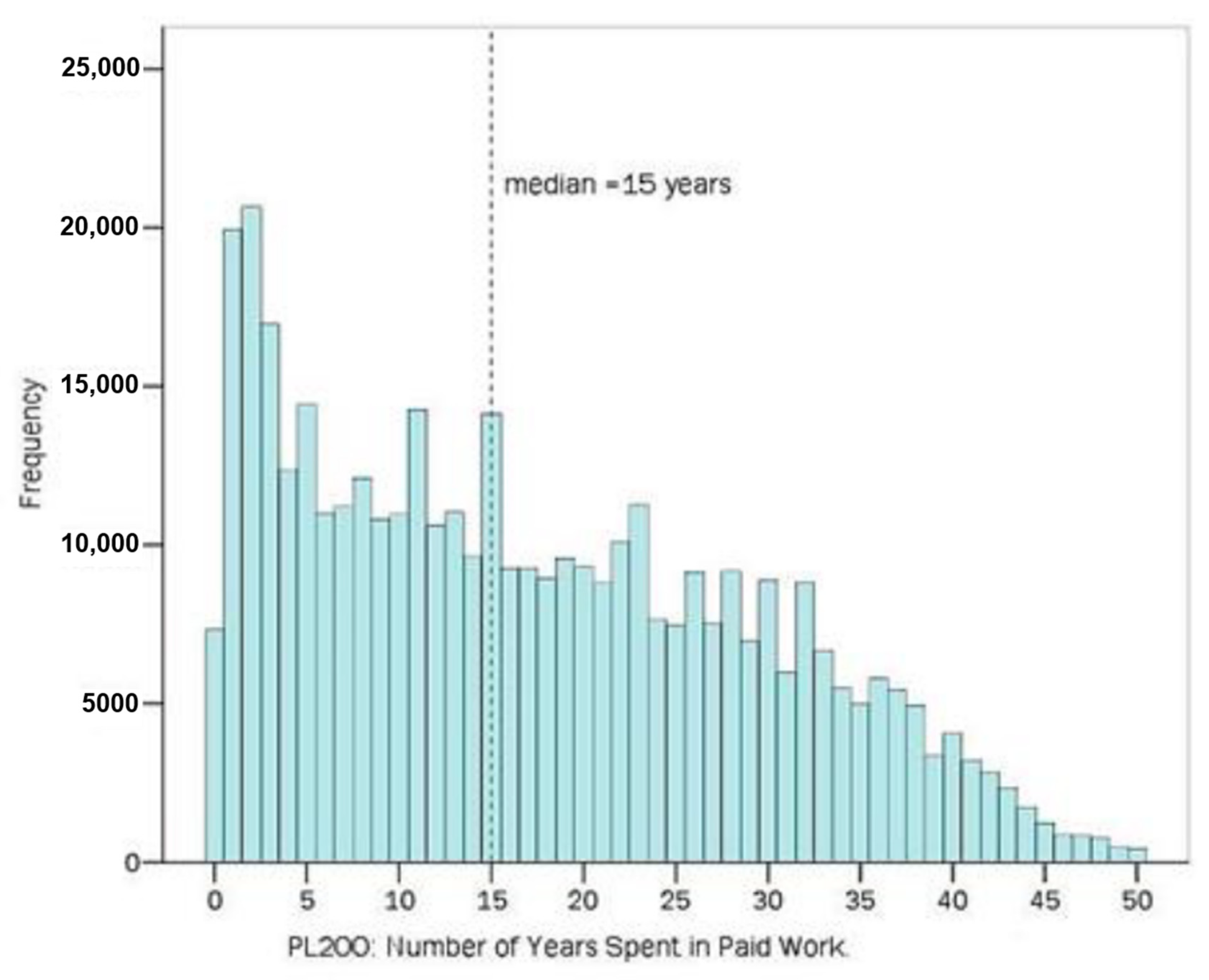
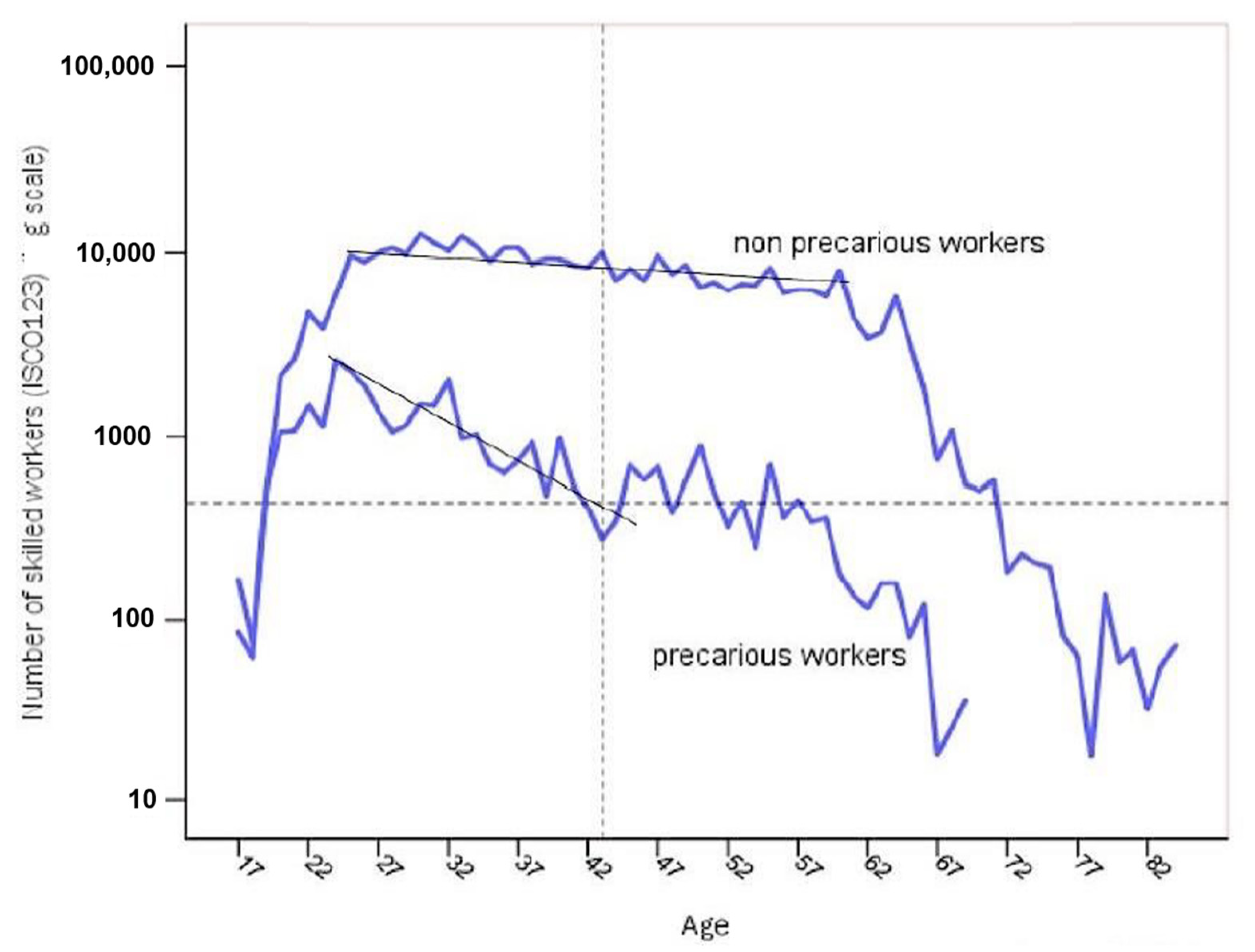

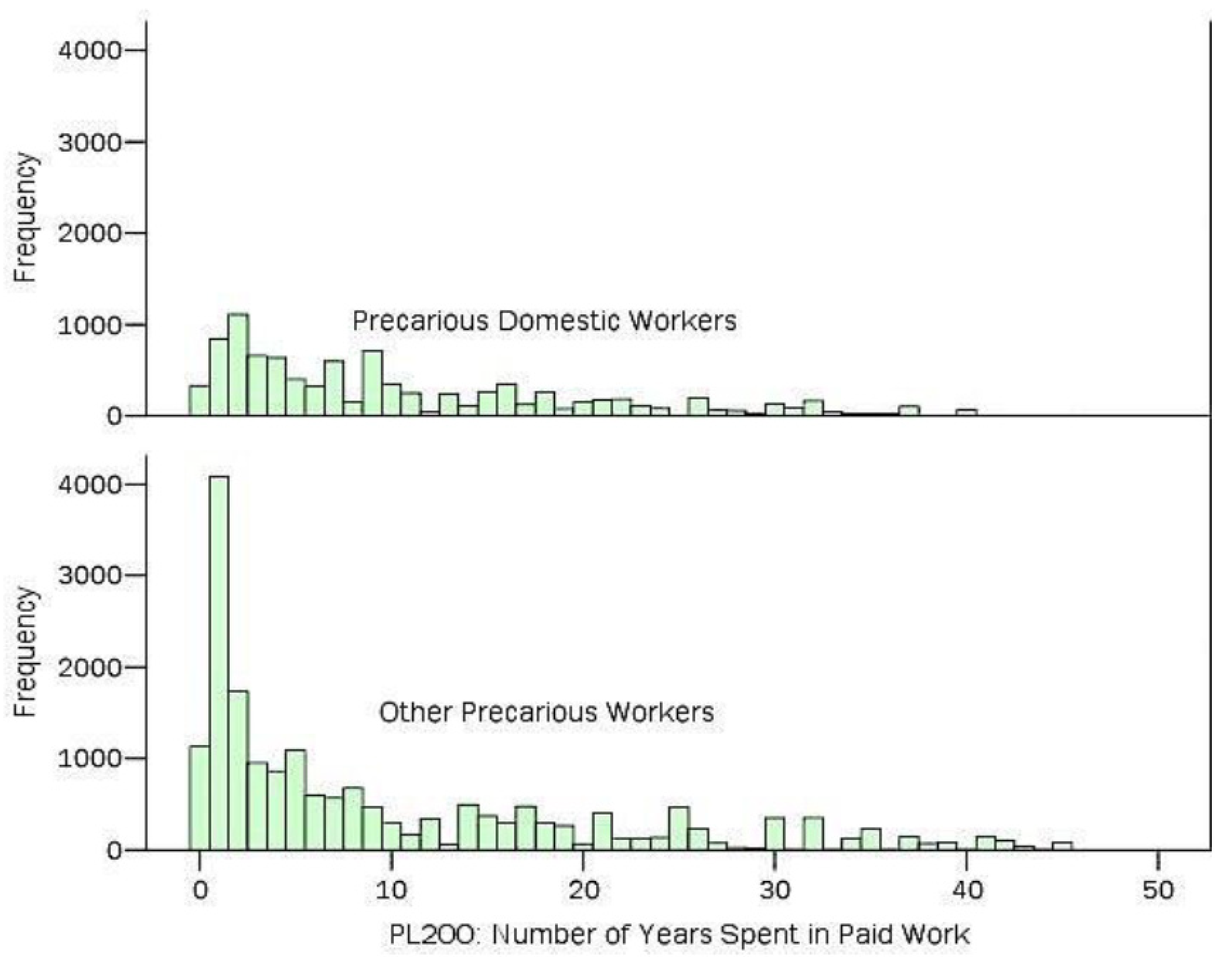

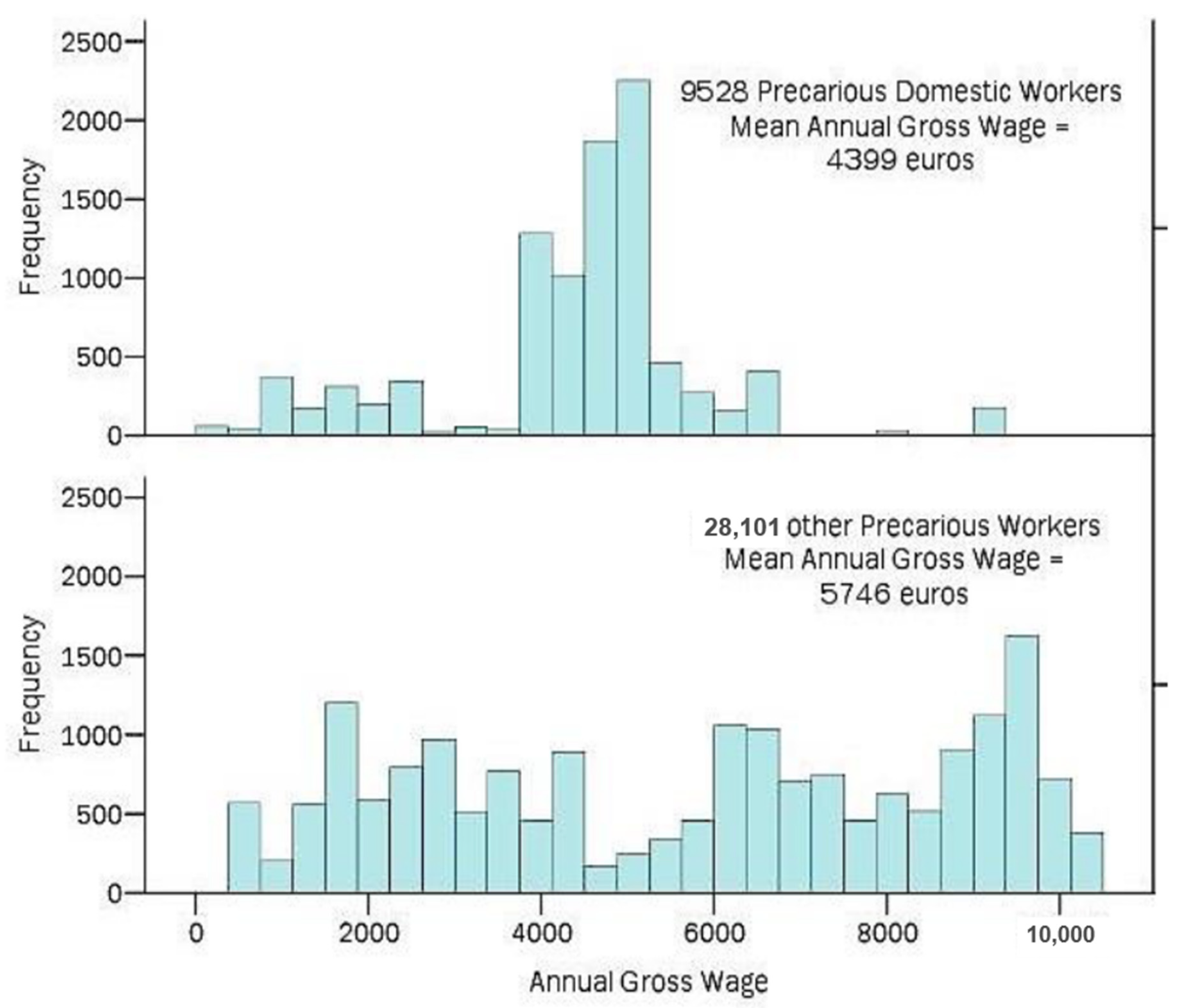

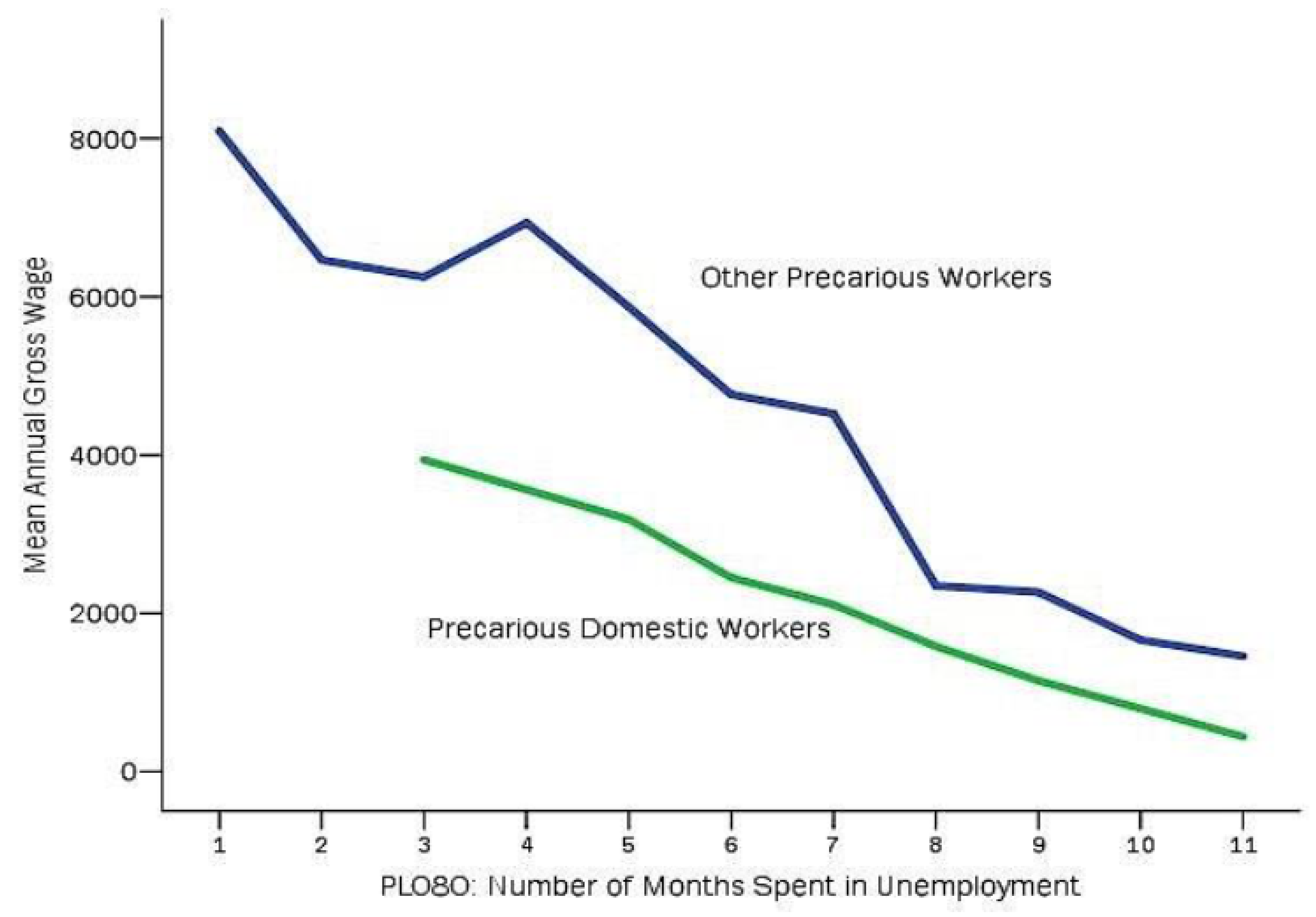
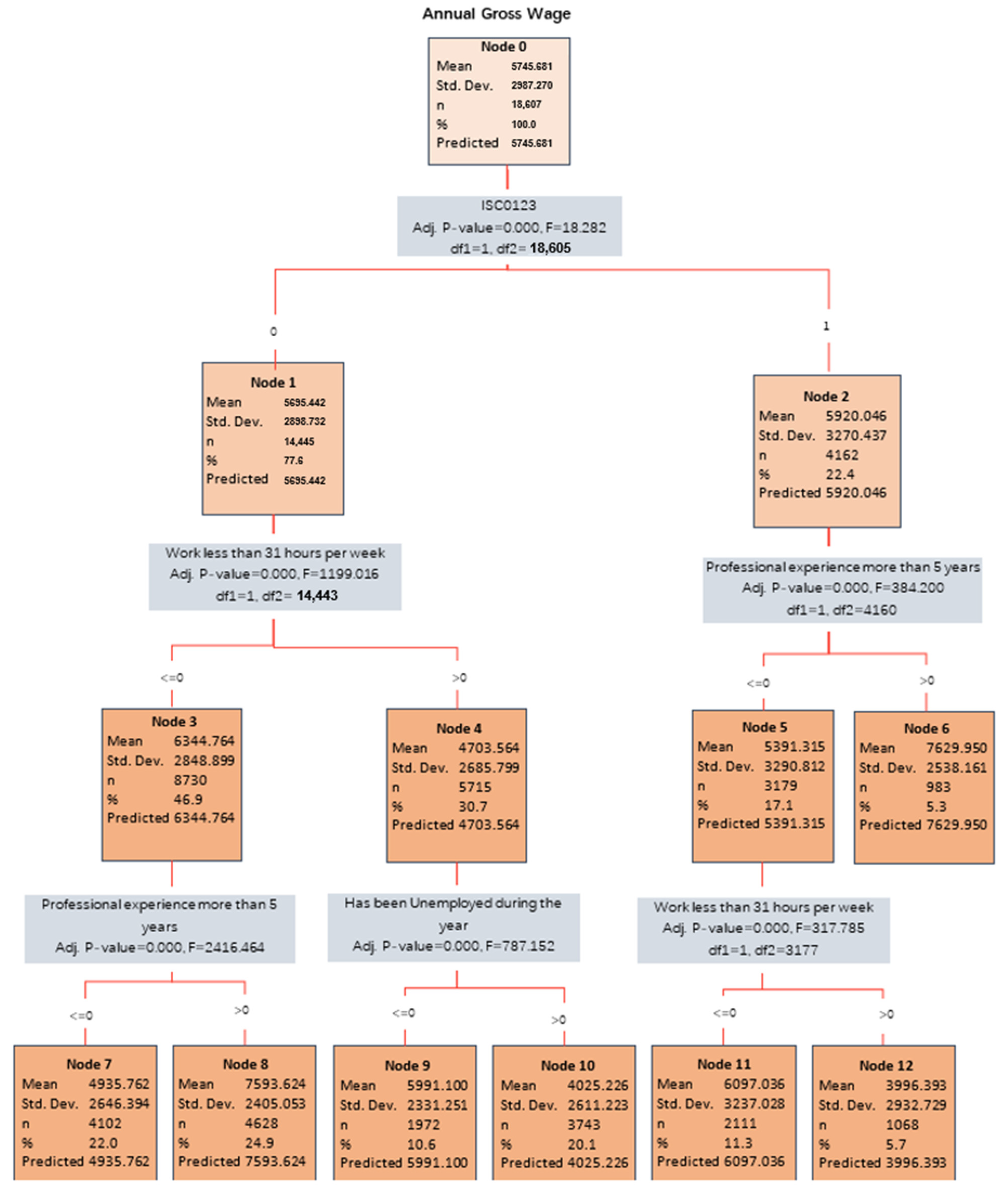
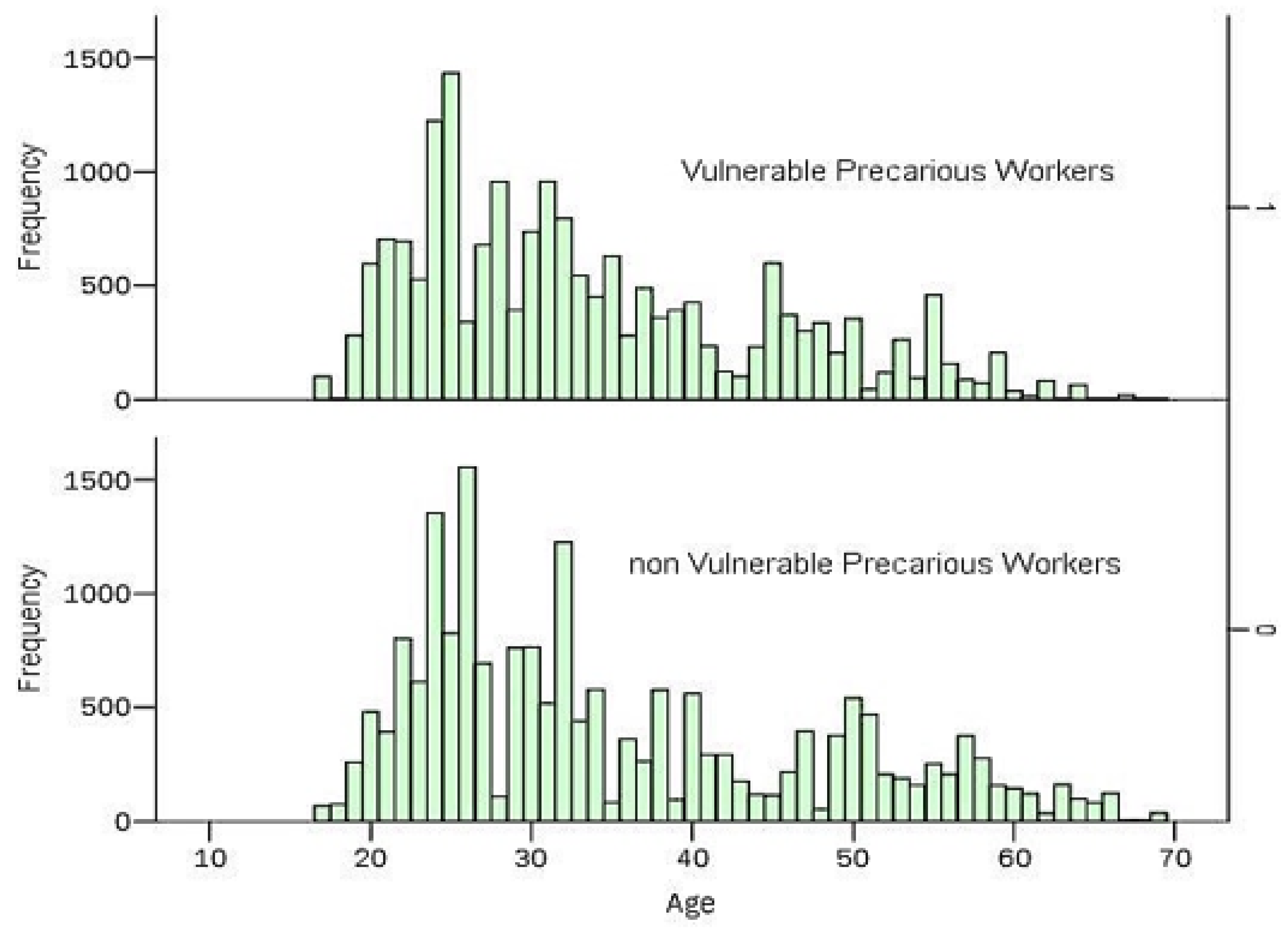

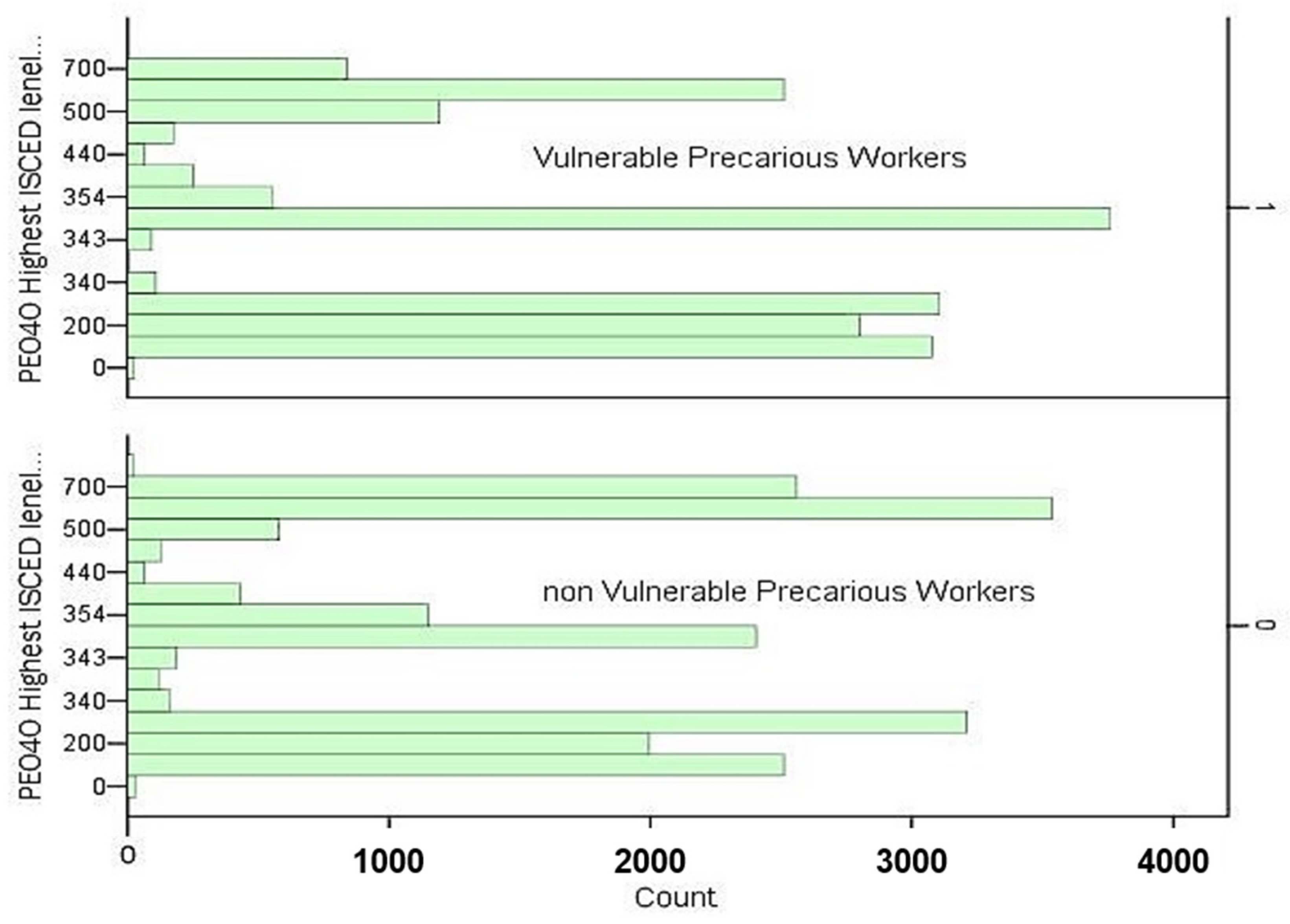
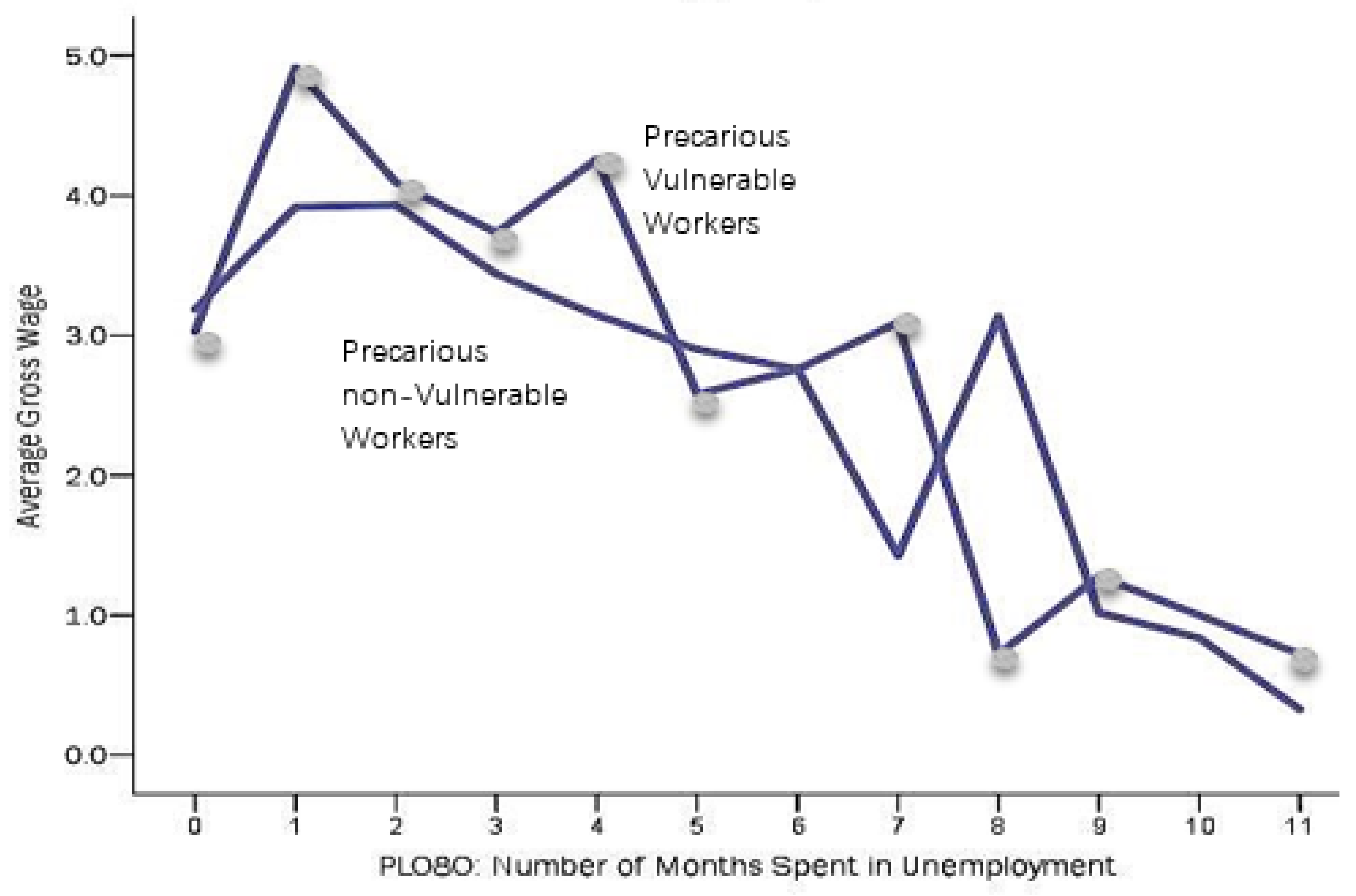
| Precarious Workers | Retail Trade | Accommodation | Restaurants | Education | Households | Total |
|---|---|---|---|---|---|---|
| Teaching Professionals | 6.4% | 6.4% | ||||
| Personal Services Workers | 4.5% | 4.7% | 9.2% | |||
| Sales | 6.5% | 6.5% | ||||
| Child Care Workers and Teachers’ Aides | 6.2% | 6.2% | ||||
| Domestic Workers | 41.1% | 41.1% | ||||
| Σ | 6.5% | 4.5% | 4.7% | 12.5% | 41.1% | 69.4% |
| Independent Variables | Definition | Designed to Capture |
|---|---|---|
| Female | Employers’ preferences, female employees’ family responsibilities, etc. | |
| ln (Age) | Age of worker | Employer’s disfavour for older employees |
| Occupations 123 | Occupations in skilled intellectual work (scientific personnel, technicians etc.) | Skilled work |
| ln (Professional Experience) | Number of years spent in paid work | Professional Experience |
| Hours usually worked weekly | Hours usually worked weekly | Differential bargaining power depending on working time |
| ln (Months in Unemployment) | Unemployment duration | Lower annual income, lower bargaining power |
| Changed jobs since last year | Changed jobs since last year | Employers’ preferences, lower bargaining power of the employee |
| Cypriot, Greek, OAS, NME | Citizenship | Employer’s preferences and/or discrimination |
| Precarious Domestic Work | Occupational idiosyncrasy | |
| Upper Secondary Education, Tertiary Education | Education attainment level | Formal knowledge and skills, ability to perform complicated tasks |
| Dependent variable: ln (Annual Gross Labour Income) | Logarithm of Annual Gross Labour Income |
| Dependent Variable: ln (Annual Gross Labour Income) | Unstandardised Coefficients | Stand. Coefficients | T | Sig. | |
|---|---|---|---|---|---|
| B | Std Error | ||||
| ln (Months in unemployment) | −0.586 | 0.006 | −0.494 | −93.338 | 0.000 |
| Hours usually worked weekly | 0.035 | 0.000 | 0.509 | 98.887 | 0.000 |
| Precarious domestic work | −0.769 | 0.016 | −0.261 | −48.824 | 0.000 |
| ln (Professional experience) | 0.128 | 0.003 | 0.201 | 38.124 | 0.000 |
| NME | −0.847 | 0.032 | −0.139 | −26.271 | 0.000 |
| Changed jobs since last year | −0.208 | 0.009 | −0.123 | −23.64 | 0.000 |
| Occupations 123 | 0.274 | 0.012 | 0.121 | 23.305 | 0.000 |
| Constant | 7.827 | 0.018 | 431.656 | 0.000 | |
| R squared = 0.69 | |||||
| Variables excluded for collinearity | Collinearity Tolerance | ||||
| Female | 0.830 | ||||
| ln Age | 0.206 | ||||
| Cypriot | 0.663 | ||||
| Greek | 0.658 | ||||
| OAS | 0.115 | ||||
| Upper Secondary Education | 0.815 | ||||
| Tertiary Education | 0.697 | ||||
| Independent Variables | Definition | Designed to Capture |
|---|---|---|
| Female | Gender (1 = Female) | Employers’ preferences, female employees’ family responsibilities etc |
| Education Primary, Lower, Secondary, Upper Secondary | Education attainment levels | Formal knowledge and skills, ability to perform complicated tasks |
| Professional Experience of more than 5 years | Number of years spent in paid work | Professional Experience |
| Unemployment of more than 3 months per year | Unemployment duration | Lower annual income, lower bargaining power |
| Cypriot, Greek, OAS, NME | Citizenship | Employers’ preferences and/or discrimination |
| Dependent variable | Risk of the precariousness of domestic workers | Determinants of the risk of the precariousness of domestic workers |
| Dependent Variable: Risk of Precariousness of Domestic Workers (n = 11,054) | B | Std Error | Wald | Sig. | exp(B) |
|---|---|---|---|---|---|
| Female | 21,592 | 940,599 | 0.001 | 0.982 | 2 × 10−9 |
| Professional Experience of more than 5 years | −2107 | 0.147 | 206,288 | 0.000 | 0.122 |
| Unemployment of more than 3 months per Year | 36,905 | 140,174 | 0.001 | 0.979 | 2 × 1016 |
| OAS | 5176 | 0.129 | 1,614,429 | 0.000 | 176,949 |
| Constant | −22,109 | 940,599 | 0.001 | 0.981 | 0.000 |
| Nagelkerke R square = 0.658 | |||||
| Cox & Snell R Square = 0.363 | |||||
| Variables excluded by stepwise logistic regression | |||||
| Education Primary, Lower, Secondary, Upper Secondary |
| Dependent Variable: Risk of Precariousness of Other than Domestic Workers (n = 350,780) | B | Std Error | Wald | Sig. |
|---|---|---|---|---|
| Female | 0.597 | 0.017 | 1255,000 | 0.000 |
| Education Primary, Lower, Secondary | 0.700 | 0.026 | 702,787 | 0.000 |
| Upper Secondary | 0.305 | 0.018 | 275,974 | 0.000 |
| Professional Experience of more than 5 years | −1663 | 0.017 | 9422,518 | 0.000 |
| Unemployment of more than 3 months per year | 2320 | 0.018 | 15,945,344 | 0.000 |
| Greek | 0.694 | 0.033 | 432,101 | 0.000 |
| BG and RO | 0.563 | 0.029 | 376,154 | 0.000 |
| OAS | 1949 | 0.053 | 1335,857 | 0.000 |
| Constant | −2834 | 0.019 | 23,283,250 | 0.000 |
| Nagelkerke R square = 0.236 | ||||
| Cox & Snell R Square = 0.080 |
Disclaimer/Publisher’s Note: The statements, opinions and data contained in all publications are solely those of the individual author(s) and contributor(s) and not of MDPI and/or the editor(s). MDPI and/or the editor(s) disclaim responsibility for any injury to people or property resulting from any ideas, methods, instructions or products referred to in the content. |
© 2023 by the authors. Licensee MDPI, Basel, Switzerland. This article is an open access article distributed under the terms and conditions of the Creative Commons Attribution (CC BY) license (https://creativecommons.org/licenses/by/4.0/).
Share and Cite
Kosmas, P.; Theocharous, A.; Ioakimoglou, E.; Giannoulis, P.; Panagopoulou, M.; Andreev, H.; Vatikioti, A. Mapping and Measuring the Phenomenon of Precariousness in the Labour Market: Challenges and Implications. Soc. Sci. 2023, 12, 61. https://doi.org/10.3390/socsci12020061
Kosmas P, Theocharous A, Ioakimoglou E, Giannoulis P, Panagopoulou M, Andreev H, Vatikioti A. Mapping and Measuring the Phenomenon of Precariousness in the Labour Market: Challenges and Implications. Social Sciences. 2023; 12(2):61. https://doi.org/10.3390/socsci12020061
Chicago/Turabian StyleKosmas, Petros, Antonis Theocharous, Elias Ioakimoglou, Petros Giannoulis, Maria Panagopoulou, Hristo Andreev, and Aggeliki Vatikioti. 2023. "Mapping and Measuring the Phenomenon of Precariousness in the Labour Market: Challenges and Implications" Social Sciences 12, no. 2: 61. https://doi.org/10.3390/socsci12020061
APA StyleKosmas, P., Theocharous, A., Ioakimoglou, E., Giannoulis, P., Panagopoulou, M., Andreev, H., & Vatikioti, A. (2023). Mapping and Measuring the Phenomenon of Precariousness in the Labour Market: Challenges and Implications. Social Sciences, 12(2), 61. https://doi.org/10.3390/socsci12020061






